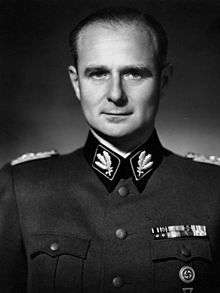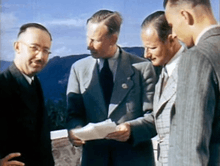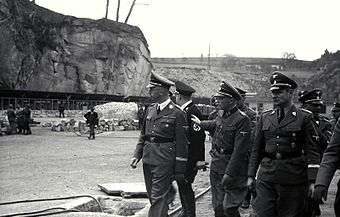Karl Wolff
Karl Wolff (13 May 1900 – 17 July 1984) was a German SS functionary and war criminal. He was Chief of Personal Staff Reichsführer-SS (Heinrich Himmler) and an SS liaison to Adolf Hitler until his replacement in 1943. He ended World War II as the Supreme SS and Police Leader in occupied Italy. Wolff evaded prosecution at the Nuremberg Trials, apparently as a result of his participation in Operation Sunrise. In 1964, Wolff was convicted of war crimes in West Germany; he was released in 1969.
Karl Wolff | |
|---|---|
 Wolff in 1937 | |
| Birth name | Karl Friedrich Otto Wolff |
| Born | 13 May 1900 Darmstadt, Grand Duchy of Hesse, German Empire |
| Died | 17 July 1984 (aged 84) Rosenheim, Bavaria, West Germany |
| Allegiance | |
| Years of service | 1917–1918 1933–1945 |
| Rank | SS-Obergruppenführer |
| Unit | |
| Commands held | Chief, Personal Staff Reichsführer-SS Supreme SS and Police Leader, occupied Italy |
| Battles/wars | World War I |
| Awards | Iron Cross, German Cross in Gold |
| Relations | Fatima Grimm (daughter) |
Early life and career
Karl Friedrich Otto Wolff was born the son of a wealthy district court magistrate in Darmstadt on 13 May 1900.[1] During World War I he graduated from school in 1917, volunteered to join the Imperial German Army (Leibgarde-Infanterie-Regiment Nr. 115) and served on the Western Front.[2] He rose to the rank of lieutenant and was awarded both the Iron Cross second class and first class.[1]
After the war, Wolff was forced to leave the army after the reduction of the German armed forces following the terms imposed by the Treaty of Versailles.[2] Wolff was in the paramilitary Freikorps from December 1918 to May 1920.[1] He started a two-year apprenticeship at the Bethmann bank in Frankfurt and married Frieda von Römheld in 1923.[3] The couple moved to Munich, where Wolff worked for Deutsche Bank. In June 1924 he was laid off and joined a public relations firm.[4] Wolff may also have studied law, but never took any state exams.[2][5] In 1925 he started his own public relations company which he operated in Munich until 1933.[4]
Nazi Party and SS

Wolff joined the Nazi Party with card number 695,131 and the SS in October 1931.[2][6] His SS membership number was 14,235 and he was commissioned as an SS-Sturmführer in February 1932.[7]
From March 1933, after the Nazi Party had obtained national power, Wolff served as an adjutant to Franz Ritter von Epp, then governor of Bavaria.[1] Here he came to the attention of the head of the SS Heinrich Himmler who appointed Wolff his personal adjutant in June 1933.[2] In 1936 Wolff became a member of the Reichstag.[1] The same year Himmler named him chief of Personal Staff Reichsführer-SS to coordinate all contact and correspondence within the SS at both party and state levels.[8]
By managing Himmler's affairs with the SS, the Nazi Party, state agencies and personnel,[9] the eloquent and well mannered Wolff rose to become one of the key figures in Himmler's power regime. In addition, Wolff oversaw the economic investments made by the SS, was responsible for saving funds among Himmler's circle of friends and for connections to the SS organizations Ahnenerbe and Lebensborn. In 1939 he retroactively became head of the Main Office and SS liaison officer to Hitler.[10] In 1936, Wolff left the Protestant Church.[11] On 30 January 1937, he was promoted to the rank of SS-Gruppenführer (major general).[12]
World War II

As was later revealed in the 1964 trial, during the early part of the Second World War Wolff was "Himmler's eyes and ears" in Hitler's headquarters. He would have been aware of significant events or could easily have access to the relevant information. Apart from the information passing across his desk, Wolff received (as Chief of Himmler's Personal Staff) copies of all letters from SS officers, and his friends at this point included Odilo Globocnik, the organiser of Operation Reinhard. His later denial of knowledge of Holocaust activities may be plausible only at the detailed level, but not of the extent of atrocities by the Nazi regime.
Incriminating letters show that Wolff was involved in the Holocaust. On 8 September 1939, shortly after the invasion of Poland, Wolff wrote to the Gestapo office in Frankfurt (Oder) and ordered the immediate "arrest of all male Jews of Polish nationality and their family members" and the confiscation of any wealth.[13] In 1942 Wolff oversaw the deportation transports during "Grossaktion Warschau", the mass extermination of Jews from the Warsaw Ghetto. When rail transport bottlenecks occurred, Wolff communicated repeatedly with Reich Railway Director Albert Ganzenmüller. In a letter sent from the Führer Headquarters, dated 13 August 1942 and referring to transports of Jews to Treblinka extermination camp, Wolff thanked Ganzenmüller for his assistance:[14]
I note with particular pleasure from your communication that a train with 5,000 members of the chosen people has been running daily for 14 days and that we are accordingly in a position to continue with this population movement at an accelerated pace. I have taken the initiative to seek out the offices involved, so that a smooth implementation of the named measures appears to be guaranteed. I thank you once again for the effort and at the same time wish to ask you to continue monitoring these things. With best wishes and Heil Hitler, yours sincerely W.
— Karl Wolff to Albert Ganzenmüller, 13 August 1942, [14]
In August 1941, Himmler and Wolff attended the shooting of Jews at Minsk which had been organised by Arthur Nebe who was in command of Einsatzgruppe B, a mobile killing unit.[15] Nauseated and shaken by the experience, Himmler decided that alternate methods of killing should be found.[16] On Himmler's orders, by the spring of 1942 the camp at Auschwitz had been greatly expanded, including the addition of gas chambers, where victims were killed using the pesticide Zyklon B.[17]
After the assassination of Reinhard Heydrich in June 1942, Wolff developed a strong rivalry with other SS leaders, particularly with Heydrich's successor at the Reich Main Security Office (Reichssicherheitshauptamt), Ernst Kaltenbrunner and with Walter Schellenberg of the foreign intelligence service in the RSHA.[18] His position was weakened by his frequent absence from Berlin, in part due to his suffering from pyelitis and renal calculus (kidney stones), which required surgery.[19] Wolff fell out of favour with Himmler and was dismissed as his chief of staff. In April 1943, he was relieved of his duties as liaison officer to Hitler. Himmler announced he would temporarily take over Wolff's duties.[20] A new replacement as liaison officer to Hitler's HQ did not occur until the appointment of Hermann Fegelein, who assumed the duty in January, 1944.[20] Wolff had particularly angered Himmler by his divorce and remarriage in March 1943. Himmler, who believed the family to be the nucleus of the SS, had denied Wolff a permission to divorce, but Wolff had turned directly to Hitler. Himmler still appears to have considered Wolff a loyal member of the SS, for in September 1943 Wolff was transferred to Italy as Supreme SS and Police Leader.[18]
In that position, Wolff shared responsibility for standard police functions such as security, maintenance of prisons, supervision of concentration camps and forced labor camps as well as the deportation of forced laborers with Wilhelm Harster, who was the Commander in Chief of the Security Police. When Wolff became Plenipotentiary General of the German Wehrmacht in July 1944, he also became responsible for antipartisan warfare in occupied Italy. By now Wolff commanded the police and the entire rear army in Italy.[21] So far Wolff's involvement in war crimes in Italy remains largely unclear, partially because source material on the degree to which SS units participated in Nazi security warfare is lacking. Although it seems as if US investigators were in possession of incriminating material in 1945, that indicated Wolff's approval of the executions that became known as the Ardeatine massacre, this evidence was deemed not sufficient for criminal charges.[22] On 9 December 1944, Wolff was awarded the German Cross in Gold for using Italian units, with secondary German units to destroy partisans and for the "maintenance of war production in the Italian territory".[23] During this period he approved the project of the Marnate's Bunker, close to the German command of Olgiate Olona.[24] By 1945 Wolff was acting military commander of Italy.
In 1945, Wolff under Operation Sunrise took over command and management of intermediaries including the Swiss national Max Waibel, in order to make contact in Switzerland with the headquarters of the US Office of Strategic Services, under Allen W. Dulles as to the surrender of German forces in and around Italy.[25] After initially meeting with Dulles in Lucerne on 8 March 1945, Wolff negotiated the surrender of all German forces in Italy, ending the war there on 29 April, before the war ended in Germany on 2 May 1945.[25] Wolff's capitulation of Italy to the Allies upset Admiral Karl Dönitz who had otherwise planned a staged series of surrenders designed to give the troops and refugees more time to make their way west.[26]
Trials and conviction
Arrested on 13 May 1945[27] he was imprisoned in Schöneberg. During the Nuremberg trials, Wolff was allowed to escape prosecution in exchange for the early capitulation in Italy and by appearing as a witness for the prosecution at trial.[12] Although released in 1947, he had been indicted by the post-war German government as part of the denazification process. Detained under house arrest, after a German trial Wolff was sentenced in November 1948 and served four years' of imprisonment.[12] After his release, Wolff worked as an executive for an advertising agency.[28]
He took up residence with his family in Starnberg. In 1962 during the trial in Israel of Adolf Eichmann, evidence showed that Wolff had organised the deportation of Italian Jews in 1944. Wolff was again tried in West Germany and in 1964 was convicted of deporting 300,000 Jews to the Treblinka extermination camp, which led to their murder. Sentenced to fifteen years' imprisonment in Straubing, Wolff served only part of his sentence and was released in 1971.[12]
Later life
After his release, Wolff retired in Austria. In the late 1970s and early 1980s, Wolff returned to public life, frequently lecturing on the internal workings of the SS and his relationship with Himmler. This resulted in him appearing in television documentaries including The World At War saying that he witnessed an execution of twenty or thirty partisan prisoners in Minsk in 1941 with Himmler.[29]
In the early 1970s, Wolff promoted the theory of an alleged plot to kidnap Pope Pius XII. Most other allegations of such a plot are based on a 1972 document written by Wolff that Avvenire d'Italia published in 1991, and on personal interviews with Wolff before his death in 1984. Wolff maintained that on 13 September 1943, Hitler gave the directive to "occupy Vatican City, secure its files and art treasures, and take the Pope and Curia to the north". Hitler allegedly did not want the Pope to "fall into the hands of the Allies".[30]
Wolff's reliability has been questioned by Holocaust historians,[31] such as István Deák, a professor of history at Columbia University.[32] Reviewing A Special Mission by Dan Kurzman, a promoter of the theory,[33] Deák noted Kurzman's "credulity" and that the latter "uncritically accepts the validity of controversial documents and unquestioningly believes in the statements made to him by his principal German interlocutor, the former SS General Karl Wolff". He further criticized the book's "modest documentation" containing "a great number of vague or inaccurate references".[33]
In the late 1970s Wolff also became involved with Stern journalist Gerd Heidemann. Together with Heidemann, he travelled through South America, where he helped to locate, among others, Klaus Barbie and Walter Rauff, with whom Heidemann conducted interviews for a series of articles. Wolff served as a consultant for the alleged Hitler Diaries, and was deeply shattered when they turned out to be forgeries by Konrad Kujau.[22] Asked to attend the trial of Heidemann and Kujau, Wolff declined; on 17 July 1984, he died in a hospital in Rosenheim. He was buried in the cemetery at Prien am Chiemsee on 21 July 1984.
Notes
Footnotes
Citations
- Wistrich 2001, p. 280.
- Lingen 2013, p. 19.
- Lang 2013, p. 12.
- Lang 2013, p. 13.
- Lang 2013, p. 40.
- Lang 2013, p. 3.
- Lilla, Döring & Schulz 2004, p. 735.
- Lingen 2013, p. 21.
- Koehl 2004, p. 126.
- Lingen 2013, pp. 21–22.
- Lang 2013, p. 36.
- Zentner & Bedürftig 1997, p. 1055.
- Lingen 2013, p. 217.
- Lingen 2013, p. 216.
- Weale 2012, p. 319.
- Weale 2012, p. 320.
- Evans 2008, pp. 295, 299–300.
- Lingen 2013, p. 23.
- Lang 2013, pp. 206–209.
- Lang 2013, p. 208.
- Lingen 2013, pp. 23, 27–28.
- Lingen 2013, p. 27.
- Lang 2013, p. 257.
- Goglio, Giuseppe. "MARNATE - Aperto al pubblico il bunker di via Lazzaretto". settenews. Archived from the original on 17 February 2017. Retrieved 24 November 2016.
- Weale 2012, p. 405.
- Kitchen 1995, p. 294.
- Allanbrook, Douglas (1995). See Naples: a memoir. Boston; New York: Houghton Mifflin Company. p. 223. ISBN 0-395-74585-3.
- Hamilton 1984, p. 364.
- Kurzman, 2007, p. 12.
- Holocaust Denial on Trial. 2009. "Use of an unreliable source: the testimony of Karl Wolff". Emory University.
- New York Review of Books. 2008, 20 November. "Can We Believe General Karl Wolff?". Vol. 55. No. 18.
- Deák, István (12 June 2008). "Did Hitler Plan to Kidnap the Pope?". The New York Review of Books. 55 (10). Retrieved 10 August 2020.
Bibliography
- Evans, Richard J. (2008). The Third Reich at War. New York: Penguin Group. ISBN 978-0-14-311671-4.CS1 maint: ref=harv (link)
- Hamilton, Charles (1984). Leaders & Personalities of the Third Reich, Vol. 1. R. James Bender Publishing. ISBN 0-912138-27-0.CS1 maint: ref=harv (link)
- Kitchen, Martin (1995). Nazi Germany at War. New York: Longman. ISBN 0-582-07387-1.CS1 maint: ref=harv (link)
- Koehl, Robert (2004). The SS: A History 1919–45. Stroud: Tempus. ISBN 978-0-7524-2559-7.CS1 maint: ref=harv (link)
- Kurzman, Dan (2007). A Special Mission: Hitler's Plot to Seize the Vatican and Kidnap Pope Pius XII. ISBN 0-306-81468-4.
- Lang, Jochen von (2013) [1985]. Top Nazi: SS General Karl Wolff. New York: Enigma Books. ISBN 978-1-936274-52-9.CS1 maint: ref=harv (link)
- Lilla, Joachim; Döring, Martin; Schulz, Andreas (2004). Statisten in Uniform: Die Mitglieder des Reichstags 1933-1945. Ein biographisches Handbuch. Unter Einbeziehung der völkischen und nationalsozialistischen Reichstagsabgeordneten ab Mai 1924. Düsseldorf: Droste. ISBN 978-3-7700-5254-7.CS1 maint: ref=harv (link)
- Lingen, Kerstin von (Spring 2008). "Conspiracy of Silence: How the "Old Boys" of American Intelligence Shielded SS General Karl Wolff from Prosecution". Holocaust and Genocide Studies. Oxford University Press. 22 (1): 74–109. doi:10.1093/hgs/dcn004.
- Lingen, Kerstin von (2013). Allen Dulles, the OSS, and Nazi War Criminals: The Dynamics of Selective Prosecution. New York: Cambridge University Press. ISBN 978-1-107-02593-6.CS1 maint: ref=harv (link)
- Weale, Adrian (2012). Army of Evil: A History of the SS. New York; Toronto: NAL Caliber (Penguin Group). ISBN 978-0-451-23791-0.CS1 maint: ref=harv (link)
- Wistrich, Robert (2001). Who's Who In Nazi Germany. New York: Routledge. ISBN 978-0-415-11888-0.CS1 maint: ref=harv (link)
- Zentner, Christian; Bedürftig, Friedemann (1997) [1991]. The Encyclopedia of the Third Reich. New York: Da Capo Press. ISBN 978-0-3068079-3-0.CS1 maint: ref=harv (link)